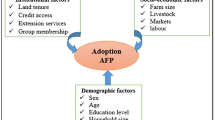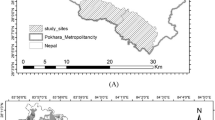Abstract
Agroforestry is a key land use in the development of ecological corridors in tropical rainforests biomes. This research tested the social dimensions of agroforestry adoption and maintenance in the Atlantic rainforest of Southern Bahia, Brazil. A quasi-experiment research design compared a group of farmers who participated in an agroforestry development program with a group of similar farmers who were not participants in the program. The effects of the program on the participants’ self-efficacy, attitudes and intentions to adopt or maintain agroforestry were tested. The effects of socio-economic factors and attitudes were also compared to self-efficacy in terms of farmers’ intentions to adopt or maintain agroforestry. Results indicate that the program neither raised nor lowered the farmers’ attitudes, self-efficacy or intentions to adopt or maintain agroforestry. However, multiple regression and logistic model analyses indicate that perceived behavioral control, attitudes about conservation and available labor contributed most significantly to farmers’ intentions to adopt or maintain agroforestry. Overall, perceived behavioral control proved to have the most significant correlation with farmers’ intentions to adopt or maintain agroforestry. Therefore, agroforestry development programs could benefit from focusing on farmers’ perceived control of certain behaviors to enhance the persistence of agroforestry practices.

Similar content being viewed by others
References
Adesina AA, Chianu J (2002) Determinants of farmers; adoption and adaptation of alley farming technology in Nigeria. Agroforest Syst 55 99–112
Ajzen I (2002) Perceived behavioral control, self-efficacy, locus of control, and the theory of planned behavior. J Appl Soc Psychol 32(4):665–683
Bandura A (1989) Regulation of cognitive processes through perceived self-efficacy. Dev Psychol 25(5):729–735
Bannister ME, Nair PKR (2003) Agroforestry adoption in Haiti: the importance of household and farm characteristics. Agroforest Syst 57:149–157
Cardoso IM et al (2001) Continual learning for agroforestry system design: university, NGO and farmer partnership in Minas Gerais, Brazil. Agric Syst (69):235–257
Casey J (2004) Agroforestry adoption in Mexico: using Keynes to better understand farmer decision making. J Post Keynes 26(3):505–521
Dipayan D (2002) Bhutan’s current environmental strategy: sustainable development through reciprocity, equality and participation. Int Rev Environ Strateg 3(2):342–349
Faminow MD, Klein KK (2001) On-farm testing and dissemination of agroforestry among slash-and-burn farmers in Nagaland, India. Dev Pract 11(4):471–486
Gist ME, Mitchell TR (1992) Self-efficacy: a theoretical analysis of its determinants and malleability. Acad Manage Rev 17(2):183–211
Gómez-Limón JA, Riesgo L, Arriaza M (2004) Multi-criteria analysis of input use in agriculture. J Agric Econ 55(3):541–564
Granek EF, Brown MA (2005) Co-management approach to marine conservation in Moheli, Comoros Islands. Conserv Biol 19(6):1724–1732
Haggar J et al (2001) Participatory design of agroforestry systems: developing farmer participatory research methods in Mexico. Dev Pract 11(4):417–424
Luszczynska A, Schwarzer R (2003) Planning and self-efficacy in the adoption the maintenance of breast self-examination: a longitudinal study on self-regulation cognitions. Psychol Health 18(1):93–108
Mittermeier RA et al (1998) Biodiversity hotspots and major tropical wilderness areas: approaches to setting conservation priorities. Conserv Biol 12(3):516–520
Multon KD, Brown SD, Lent RW (1991) Relation of self-efficacy beliefs to academic outcomes: a meta-analytic investigation. J Counsel Psychol 38(1):30–38
Muschler RG, Bonnemann A (1997) Potentials and limitations of agroforestry for changing land use in the tropics: experiences from Central America. For Ecol Manage 91:61–73
Naughton-Treves L et al (2005) The role of protected areas in conserving biodiversity and sustaining local livelihoods. Annu Rev Environ Resour 30(1):219
Neupane RP et al (2002) Adoption of agroforestry in the hills of Nepal: a logistic analysis. Agric Syst 72:177–196
O’Doherty R (1998) The theory of the contingent valuation method. Hume Pap Public Policy 6(3):67
Petrovich A (2004) Teaching notes: using self-efficacy theory in social work teaching. J Soc Work Educ 40(3):429–443
Resnick B (2002) The impact of self-efficacy and outcome expectations on functional status in older adults. Top Geriatr Rehabil 17(4):1–10
Rogers E (1995) Diffusion of innovation. The Free Press, New York, NY
Scherr S (1995) Economic factors in farmer adoption of agroforestry: pattern observed in Western Kenya. World Dev 2(5):787–804
Schroth G, da Fonseca GAB, Harvey CA, Gaston C, Vasconcelos HL, Izac A-MN (2004) Agroforestry and biodiversity conservation in tropical landscapes. Island Press, Washington
Schunk DH (1991) Self-efficacy and academic motivation. Educ Psychol 26(3):207–231
Swedberg R (1998) Max Weber’s vision of economic sociology. J Socio-Econ 27(4):535–556
Thangata PH, Alavalapati JRR (2003) Agroforestry adoption in southern Malawi: the case of mixed intercropping of Gliricidia sepium and maize. Agroforest Syst 78:57–71
Thiollay J (1995) The role of traditional agroforests in the conservation of rain forest bird diversity in Sumatra. Conserv Biol 9(2):335–353
Ticktin T (2004) The ecological implications of harvesting non-timber forest products. J Appl Ecol 41:11–21
Zafirovski LM (1999) A socio-economic approach to market transactions. J Socio-Econ 28(3):309–335
Zubair M, Garforth C (2006) Farm level tree planting in Pakistan: the role of farmer’s perceptions and attitudes. Agroforest Syst 66(3):217–229
Acknowledgements
The authors want to thank the NSEP David L. Boren fellowship for supporting this research project. The authors also want to extend a special thank you to the School for Natural Resources and Environment and the Tropical Conservation and Development program at the University of Florida in Gainesville for their training and financial support.
Author information
Authors and Affiliations
Corresponding author
Rights and permissions
About this article
Cite this article
McGinty, M.M., Swisher, M.E. & Alavalapati, J. Agroforestry adoption and maintenance: self-efficacy, attitudes and socio-economic factors. Agroforest Syst 73, 99–108 (2008). https://doi.org/10.1007/s10457-008-9114-9
Received:
Accepted:
Published:
Issue Date:
DOI: https://doi.org/10.1007/s10457-008-9114-9




